Though referred to locally as simply the “Bird Museum”, the Western Foundation of Vertebrate Zoology (WFVZ) Bird Museum and Research Center is much more than just a museum! Our mission is “to contribute to the study, knowledge, and conservation of the world’s wild bird species through biodiversity activities involving our bird collections, education programs, research projects, and publications.”
We offer tours which allow us to share the importance of bird conservation and how our egg, nest, and skin study specimens contribute to this work. For educational groups, such as school groups, we offer specific activities that will make students think more about the natural world and their role in it in a way that is different from how they may be taught in a formal classroom setting. We also offer our own bird classes for both professionals and those who may be new to bird identification.
While the WFVZ Bird Museum’s specimens are valuable to all of our visitors, they are incredibly useful for researchers using our specimens for their projects. Researchers may come to the museum to conduct their studies or we may loan specimens out to researchers. We also digitize all of our specimens and make them publicly available on our online collections database, which can be found here.
Currently, we conduct our own studies on bird conservation at our three study sites; the Santa Clara River, the northern Channel Islands and Channel Islands National Park, and the Santa Monica Mountains National Recreation Area.
To learn more about what we do, please visit our About Us page.
The History of the WFVZ Bird Museum and Research Center
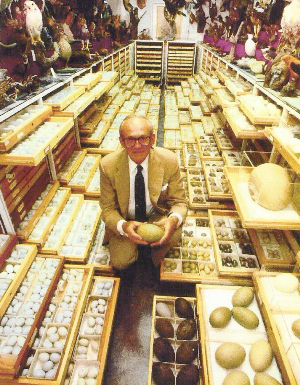
The Western Foundation of Vertebrate Zoology (WFVZ) Bird Museum and Research Center was founded in 1956 by Ed Harrison, a Los Angeles businessman, wildlife photographer, and collector of bird eggs, nests, skins, and natural history books. Born in Cody, Wyoming, in September 1914, Ed Harrison moved with his family to southern California when he was about 13 years old, living on land that his father had purchased. Today, that land forms part of the campus of the University of California, Los Angeles.
In the early 1930s, Ed spent much of his time collecting bird eggs, nests, skins, and other natural history materials. He was especially passionate about birds, and through the mentorship of ornithologist, geologist, and friend J. R. “Bill” Pemberton, Ed collected many specimens for his own personal collection.
Some of Ed Harrison’s associates (Frances Roberts, Bill Pemberton, and William Sheffler) served as founding Board Members of the WFVZ Bird Museum. Their idea was to create a safe place for their own materials and a national repository for egg and nest collections that were being “orphaned” by the death of contemporary collectors or being deaccessioned by institutions no longer interested in curating eggs. In addition, Ed saw the usefulness of eggs, nests, and bird skins to the conservation of bird species around the world and thought that it would be a shame for science to lose such materials. Shortly after the WFVZ Bird Museum’s founding, Ed contributed approximately 11,000 egg sets, 2,000 nests, and 1,750 bird study skins from his personal collection of avian materials. After Sheffler’s death in 1968, an additional 4,000 egg sets and 300 nests were given to the WFVZ Bird Museum by Sheffler’s relatives.
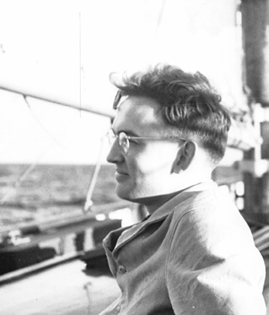

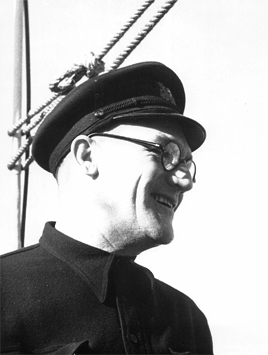
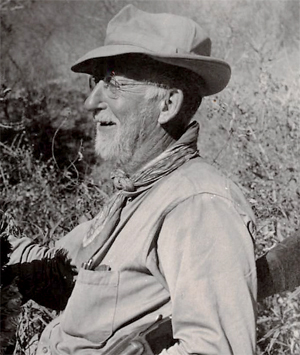
Ed Harrison Francis Roberts Bill Pemberton William Sheffler
From 1956 until the early 1990s, all of the WFVZ Bird Museum bird materials were stored in a “museum” behind Ed’s home in Brentwood, California and in the basement of an office building Ed owned in Westwood, Los Angeles. By 1968, the WFVZ Bird Museum was rapidly becoming the largest depository for egg collections in North America. At about 30,000 sets, it had grown even larger than the huge collection amassed separately by another collector of collections, Wilson C. Hanna (1883-1982), of Colton, California, who had been Harrison’s main competition for several decades.
Dr. Jean Delacour was added to the Board of Trustees; Delacour, then the Director of the Los Angeles County Museum of Natural History, was the world’s foremost aviculturist and a renowned figure in global bird conservation and ornithological research. Ed also hired Lloyd Kiff to curate the collection for him, and between 1968 and 1994, Lloyd taxonomically arranged all of the materials, oversaw the daily management of the museum, and assisted in the procurement of egg and nest collections from around the world. During this period of time, Ed personally funded (and obtained funding for) collecting expeditions to Alaska, American Samoa, Argentina, Chile, Costa Rica, East Africa, Ecuador, Guatemala, Kenya, New Caledonia, the Philippines, Uganda, Madagascar, Mexico, and Sabah (East Malaysia). He also financed field studies on particular bird species in Arizona; Ellesmere Island, Canada; and Greenland.
Ed also financed the WFVZ Bird Museum’s acquisition of more than 40 sizeable private egg and nest collections, including those of Nelson Hoy and J. Warren Jacobs in Pennsylvania; Robert D. Etchecopar of France; and George Brem, Nelson Carpenter, Fred Truesdale, and Col. L. R. Wolfe of California. Additional egg and nest collections were donated or given as permanent loans by nearly 20 institutions, including Louisiana State University, the Los Angeles County Museum of Natural History, the San Diego Natural History Museum, and the Santa Barbara Museum of Natural History. Most of the materials donated dated from the mid-1800s to World War II.
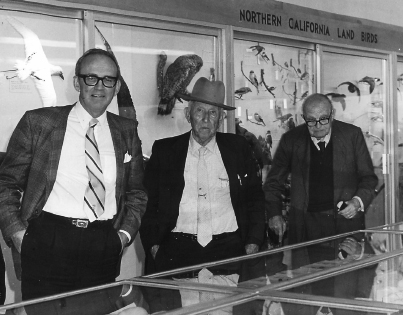
Ed Harrison, Willson C. Hanna, and Jean Delacour in 1960
In 1992, when Ed’s collections grew too large to keep at the two sites in Los Angeles, the WFVZ Bird Museum’s employees René Corado and Clark “Sam” Sumida moved 600 cabinets full of bird eggs, nests, and study skins to the present location of the WFVZ Bird Museum in Camarillo, California, about one hour north of Los Angeles (without breaking any eggs!).
From 1995 to 2007, the WFVZ Bird Museum acquired additional egg and nest collections from James Calder, Elliott McClure, the Kern County Natural History Museum, and the Bower Museum in California (the H. A. Arden collection); and from the Philadelphia Academy of Natural Sciences and the Bowman Hills Wildflower Preserve in Pennsylvania (the C. Platt collection).
In 2002, Dr. Linnea Hall began as a Director of the Museum. Her emphasis has been on adding cabinets; digitizing egg, nest, and skin records; correcting errors in the records of the WFVZ Bird Museum; and expanding educational opportunities. In 2008, she and the Board secured funding to construct a classroom, and, in 2012, she and the WFVZ Bird Museum received a 3-year grant from the National Science Foundation to digitize more than 100,000 songbird egg records, photograph 83,000 egg sets, and georeference 75,000 records. In addition to working with the collections, she has added tours, classes, and a membership base to the WFVZ Bird Museum. Now, more than 2,000 people visit the collections each year! She also has started local ornithology research projects that include monitoring birds on the Channel Islands, in the Santa Monica Mountains, and on the Santa Clara River.
To date, more than 400 different collections have been incorporated into the holdings of the WFVZ Bird Museum. Today, the collections of the WFVZ Bird Museum include more than 250,000 sets of eggs with data, 20,000 nests, and 58,000 bird study skins. The nest collection is the largest collection of its kind in the world, and the egg collection is also one of the largest collections in the world, joined by the British Museum of Natural History. The holdings of the WFVZ Bird Museum also include a “broken egg” collection containing thousands of eggs, with data, that can be used for analyses requiring the destruction of eggshells, and a “no data” egg and nest collection containing thousands of specimens that can be used for display and teaching purposes.


Sources:
Purcell, R., Hall, L.S., and Corado, R. 2008. Egg & Nest. The Belknap Press of Harvard University Press. pp. 21-27
Kiff, L.F.1994. A History of the Western Foundation of Vertebrate Zoology 1956-1994. In Davis JR, William. E. and Jackson, Jerome E.,Contributions to The History of North American Ornithology (Vol II, pp. 183). Cambride, MA: Nuttall Ornithological Club.
